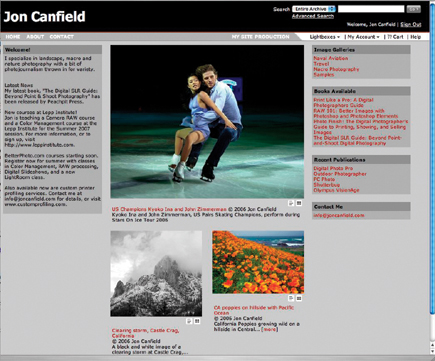Output Options; Online Or Else; Show Your Images On The Web Page 2
Stock Agencies
Agencies are a good news/bad news situation. The good news is that you don't need to worry about posting images or maintaining a website. You send your images, either via CD or FTP, to the agency, and they handle the rest. The other good part of stock agencies is that buyers know to go there to search for images. If your work is good and the subject in demand, you can make some money with sites like Alamy (www.alamy.com) and iStockphoto (www.istockphoto.com). The bad news is that you're competing with thousands of other photographers for attention and sales; prices are generally lower than you'd get on your own; and you lose a large percentage of your sale in commission fees. But, if you just don't want to deal with having a website, this might be a good approach. Before you do though, take a good look at the next option--the hybrid stock and website like that offered by Digital Railroad.
 |
|
|
Digital Archives
Like stock agencies, online archives have an advantage over the individual site
in pulling people to their site to search for images. Where the archive departs
is in the business model. Digital Railroad (www.digitalrailroad.net) is the
best example of this new way of doing business. Here, you set up an archive
that can contain as many images as you like, which are stored in portfolios.
If needed, the portfolios can be marked as private, allowing only those you
authorize to view images, or public, which can be seen by anyone.
Rather than just having your images appear in a search query, you have a homepage
that can be customized for your needs, and updated as often as you'd like.
In fact, it's a good idea to update the page frequently to keep it fresh
and bring people back.
Digital Railroad encourages you to upload the highest resolution files you
can or want, and they will handle the digital side of the transaction for you--the
customer can specify the size image they need, and what the intended use will
be. Digital Railroad sends the customer a link to download the purchased image,
and you're paid directly. This differs from a stock agency in that you
control pricing, rights usage, and keep the bulk of the money (95 percent goes
back to you).
Although Digital Railroad has been very successful for a number of photographers,
the new Marketplace feature has opened the door to more sales and more potential
buyers. You have the option to sell rights managed or royalty-free. You keep
80 percent of the sale for your images, a huge improvement over the current
setup in most stock agencies--and it's getting worse all the time.
Jon Canfield is the author of several books on digital imaging and printing.
A popular instructor at BetterPhoto.com, Canfield also teaches workshops for
the Panasonic Digital Photo Academy (www.digitalphotoacademy.com).
You can reach Canfield via e-mail at: jon@joncanfield.com.
- Log in or register to post comments
















































